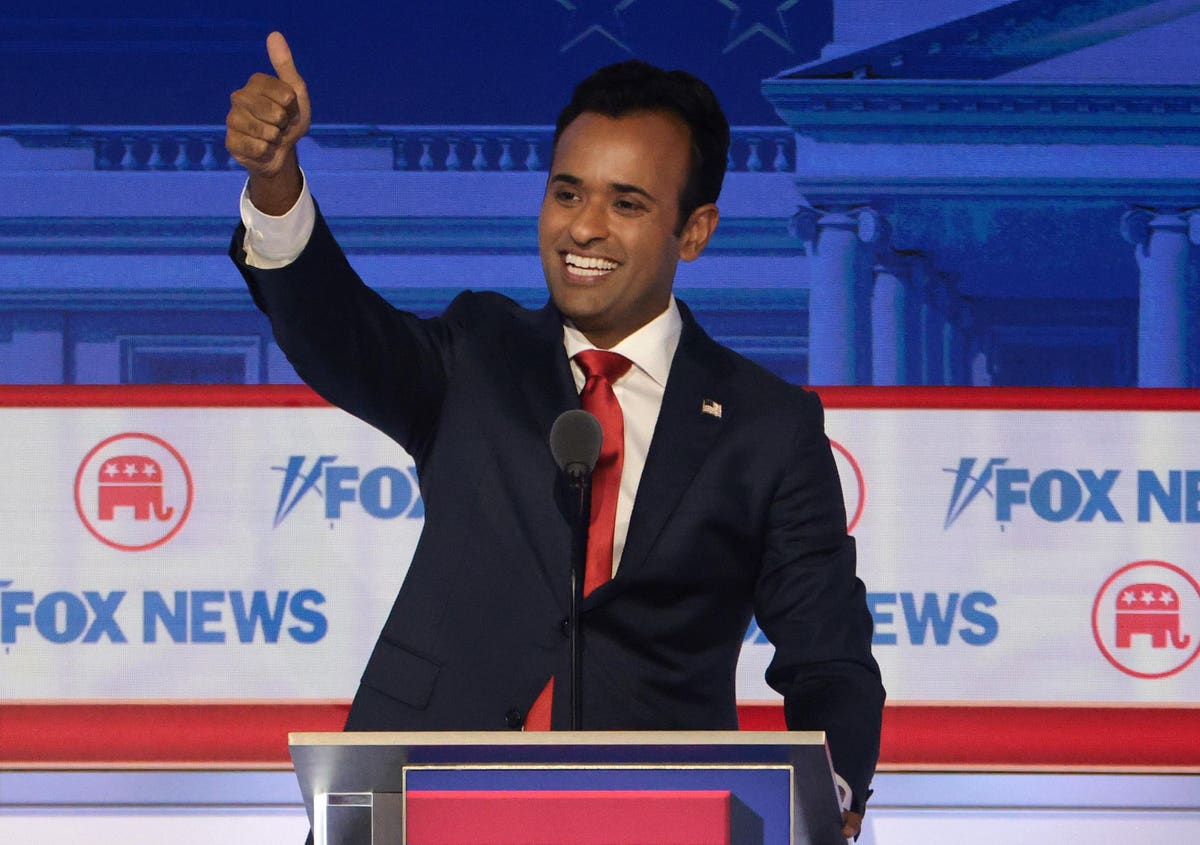Following the first Republican presidential primary debate, businessman Vivek Ramaswamy seems to be having a moment. That makes it a good time to explore his unorthodox fiscal agenda.
While in many respects his platform appears to be standard Republican playbook, it includes some real surprises. But his unrealistic assumptions, yawning gaps, constant evolution, and internal inconsistencies make it hard to know how he’d lead the nation’s tax and budget policy.
You won’t find many specifics on Ramaswamy’s campaign website, but he is more forthcoming in his many public appearances. In sum, Ramaswamy insists the nation can grow its way out of the federal debt even as he’d significantly cut taxes, especially for the wealthy. And he identifies few ways to cut spending other than by slashing the federal civilian workforce, which accounted for about 5% of federal spending in 2016.
Historic Growth, But How?
Ramaswamy insists his economic policies, which also are largely unspecified, would allow the U.S. to grow its way out of its $26 trillion public debt and end its annual deficits, now 5.9% of the gross domestic product (GDP).
He promises 5%-plus annual economic growth, a level reached only twice in the past 40 years, and both times for one year following a recession. But he insists even 3% growth would eliminate budget deficits.
Ramaswamy seems to ignore that the two biggest drivers of growth are improved worker productivity and increases in the labor force. There is little government policy can do in the short run to boost productivity, which is largely a result of technological advances. And all it could do to increase the labor force is open the door to significant immigration, but Ramaswamy favors more curbs on new immigrants and would deport undocumented workers already in the U.S.
But to his point, would 3% annual GDP growth eliminate the budget deficit? Nope. By one estimate, labor productivity would have to triple for decades to even bring the debt back to historical levels.
Up And Down On Taxes
Curiously, tax cuts seem to be something of an afterthought for Ramaswamy. In a May 18 interview with Wall Street Journal editorial page editor Paul Gigot, Ramaswamy tried to explain why he focuses so much on regulatory and monetary reform and so little on tax policy.
His explanation: “Reducing taxes is absolutely table stakes for being a pro-growth candidate, and I am, but you’re just hearing me put more of an emphasis on what I don’t even require necessarily the permission or forgiveness of Congress to do.”
In July, Ramaswamy signed Americans for Tax Reform’s no-tax-increase pledge, according to the group’s website. But in his 2022 book, Nation of Victims, he seemed to embrace a 59% tax on inherited wealth he said was proposed by progressive economists Thomas Piketty and Emmanuel Saez. While it is not quite what they suggested, it is close.
Ramaswamy wrote he was not wedded to 59% but said, “The point is the inheritance rate should be very high. If anything, I’d take the figure Piketty and Saez arrive at as a minimum.”
Such a levy would clearly violate his pledge and he has since walked it back, calling it merely a “mathematical calculation.” Indeed, he now says he opposes any “death tax.”
Ramaswamy also has been largely silent about whether to make permanent the individual provisions of the 2017 Tax Cuts and Jobs Act, a step that would add more than $3 trillion to the debt over 10 years.
A 12% Flat Tax
However, he says he does favor a 12% flat tax “eliminating cronyist (sic) deductions and loopholes.” Maybe that means a flat rate income tax. Or perhaps the Fair Tax. The Tax Policy Center estimates such a national sales tax levied at a tax inclusive rate of 23% (a 30% markup at the register) would add nearly $18 trillion to the federal debt over a decade, assuming a reasonable amount of tax avoidance.
Oddly, Ramaswamy buries his plan on a website page where he denies supporting the estate tax. It is a curious place to talk about completely remaking the federal tax system.
Ramaswamy also says he’d eliminate the IRS (among many other federal agencies), a promise made by many Fair Tax supporters. He does not explain who would collect and administer his new tax proposal.
Mostly Silent On Spending
Ramaswamy avoids discussing spending reductions. For example, asked at a New Hampshire town hall about Social Security, his only response was “no cuts for seniors” before he pivoted back to his pitch for 5% GDP growth. He said he would address “quirks” in the program only after the nation reaches that growth target.
When it comes to monetary policy, he promised to cut staff at the Federal Reserve by 90%, repeal its mandate to target full employment, and create a “stable dollar” by tying it to a “basket of commodities.” But research suggests that in the (mostly developing) countries that link their currencies to commodities, the practice makes currency more volatile, not more stable.
Vivek Ramasawmy is a talented political performer who grabbed much of the attention at last week’s GOP debate. But his economic policy agenda is incoherent.
Read the full article here









